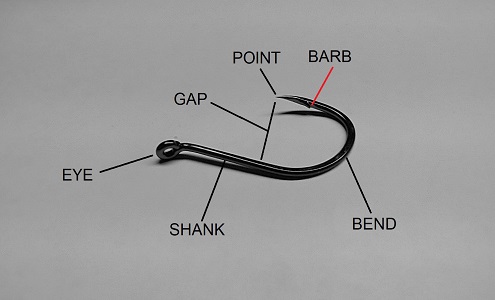Fishing Hook Anatomy

Eye
The eye of a hook is where you attach the hook to your line.
A ringed or ball eye is when the wire from the end of the hook is formed into a loop and crimped shut. The ringed or ball eye is the standard eye type on modern fishing hooks. Although some ball eye hooks can seem very clean and flush it is not perfectly formed. This shouldn't be confused with hooks that have solid rings attached to the eye. (Those are sometimes called a "ringed hook" or "hook with ring")
A tapered eye is when the diameter of the wire tapers to a smaller diameter at the end of the eye wire.
Brazed or welded eye is when the gap between the end of the eye and the hook shank is completely closed and solid for a seamless surface.
A looped eye is when the end of the eye wire continues down parallel to the shank instead of crimped into a loop.
A spade end is technically not a hook eye, but rather an eyeless hook.



The eye can also vary in its orientation. Instead of being parallel to the shank, it can be angled. In the case of the eye being angled up and away from the point, it is called an up eye. In the case of the eye being angled down and towards the point, it is called a down eye.


The other point of consideration for an eye of a hook is its size. For the vast majority of hooks, they only come in one eye size, something reasonable to accommodate the typical line used with the hook. For big game hooks, you sometimes need to use such thick diameter line that the hook is designed with an extra large eye. Another speciality hook is fly fishing hooks with oversized eyes to make it easier for the angler to thread and tie. (Since the standard eye is so tiny) These hooks are typically just called "large eye" hooks.
Shank
The shank is the straight section of wire down from the eye end of the hook.
Hook shanks can vary in length from short to long.


Bend
The bend of the hook is probably the most nuanced and contentious section of the hook. Manufacturers of hooks will say their specific bend offers better strength, penetration, or hook-up ratio. There are too many hook bends to list them all, some example illustrations of aberdeen, limerick, and o'shaugnessy bends are given below.



Point Bends
The bend of the point refers to the direction from roughly the hook bend to the tip of the point relative to the shank of the hook. The easiest way to visualize or check is to place the hook flat on the table. If the hook is flush with the surface and can't be rocked or moved up and down it is known as a straight or inline point. If the hook is lifted off the surface / can be rocked around it is a kirbed or offset point. The degree of the bend ranges from slightly noticeable to quite severe.
As a practical matter, it is easier to impale bait on a bent point hook. It is a long running debate, however, if a bent point is favorable for hooking and keeping fish on.
When it comes to circle hooks, if the hook point is inline or bent is of great importance. There are now fishing regulations that require circle hooks to be inline points. Many sportfishing tournaments require it as well.



Point
The point of the hook is the sharp bit that stabs into the fish. Similar to how there are various grinds to put a sharp edge on a blade, there are also various methods to put a point on a hook. Naturally, the hook manufacturer will argue their hook point is sharper and dulls slower.
Barb
A barb is an optional feature of a hook that is designed to easily stab into flesh but is harder to remove by pulling out. In some locales and fisheries, the use of barbed hooks is outlawed. Hooks can be purchased barbless but also the angler can crush down the barb with a pair of pliers.
Gap
The gap of a hook is the distance between the point of the hook and the shank. At the time of the hookset, there must be adequate space or the hook point will be unable to penetrate the fish.